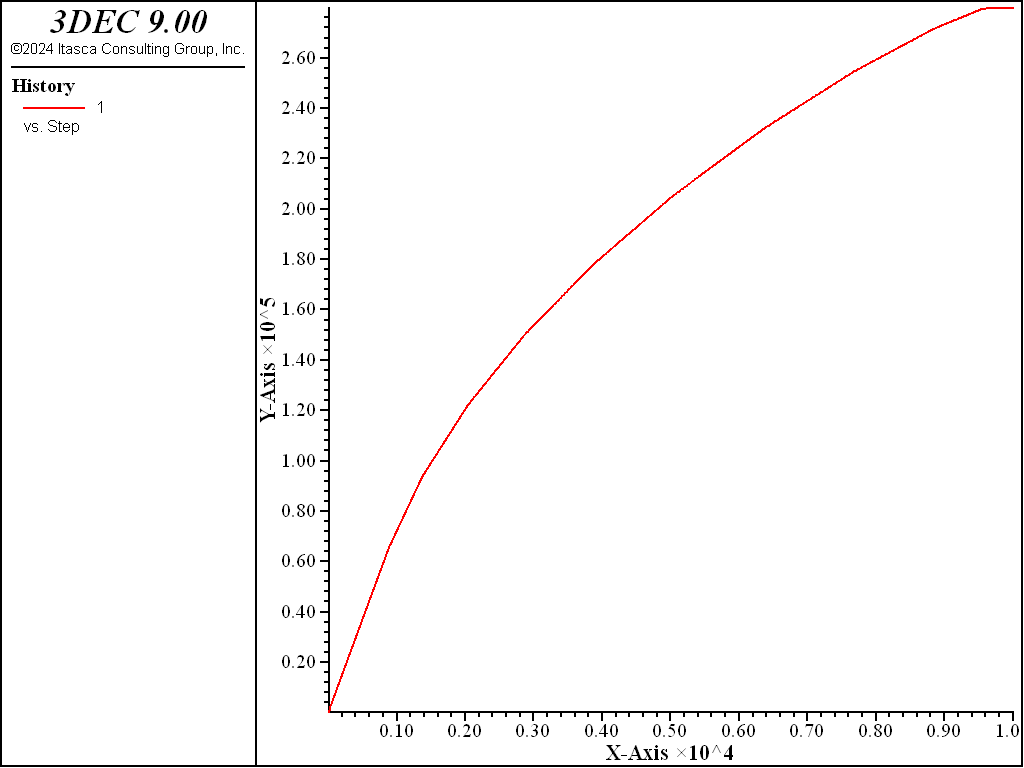Example: Pull-Test for a Grouted Cable Anchor
Problem Statement
Note
The project file for this example may be viewed/run in 3DEC.[1] The data files used are shown at the end of this example.
The most common way to determine cable bolt properties is to perform pull-out tests on small segments of grouted cables in the field. Typically, segments from 10 to 50 cm in length are grouted into boreholes. The ends of these segments are pulled with a jack mounted to the surface of the tunnel, and connected to the cable via a barrel-and-wedge type anchor. The force applied to the cable and the deformation of the cable are plotted to produce an axial force/deflection curve. From this curve, the peak shear strength of the grout bond is normally determined and converted to a strength in tons/m cable length.
In this example, we simulate a pull-test on a single 15.2 mm diameter cable. The cable material properties are:
cable area |
181 mm2 |
cable modulus |
98.6 GPa |
cable bond length |
17.7 m |
cable tensile capacity |
0.5 MN |
We select the following properties for the grout:
grout bond stiffness |
112 MN/m/m |
grout cohesive strength |
0.175 MN/m |
These values are representative of a weak grout (e.g., see Hyett et al. 1992). Note that the cable length and grout strength are selected for rapid execution of the model. The purpose is to illustrate the performance of the cable elements.
The cable is divided into 10 segments. The pull force is applied by specifying a velocity for the first node.
FISH function pullf is used to monitor the pull force on the cable (pull force per cable length).
The pull force is determined from the sum of reaction forces that develop on the block as the cable is pulled. Note that the reaction force is set to zero at the end of cycling, so the pull force calculation in pullf ends one step before cycling stops. The data file for this model is shown in pullout.dat
Figure 1 displays the axial force distribution in the cable at the end of the test. A plot of the total pull force versus displacement resulting from the test is shown in Figure 2. As this figure shows, the peak load is very similar to the input value for grout cohesive strength.

Figure 1: Axial force in the cable for the pull test.

Figure 2: Cable grout shear force in N/m versus cable displacement in meters (grout friction = 0).
The cable shear bond strength will, in general, increase with increasing effective pressure acting on the cable. In the above model that does not occur because the frictional strength of the grout was set to 0. To test the dependency on confining stress, the same model is run but a non-zero grout friction and perimeter are assigned. The friction angle of the grout is set to 30◦. The perimeter is set assuming the hole diameter is twice the cable diameter. Inline FISH is used to perform the calculation. The result of this test is shown in Figure 3. You can see that this bolt is indeed stronger than the bolt with zero frictional grout strength.

Figure 3: Cable grout shear force in N/m versus cable displacement in meters (grout friction = 30◦).
References
Hyett, A. J., W. F. Bawden and R. D. Reichert. “The Effect of Rock Mass Confinement on the Bond Strength of Fully Grouted Cable Bolts,” Int. J. Rock Mech. Min. Sci. & Geomech. Abstr., 29(5), 503-524 (1992).
Data Files
pullout.dat
model new
model random 10000
model large-strain on
block create brick -1,1 -1,1 -2,0
block zone generate edgelength .5
block zone cmodel assign elastic
block zone property bulk 5e9 shear 3e9 density 2500
block gridpoint apply velocity 0 0 0 range position-x -1
block gridpoint apply velocity 0 0 0 range position-x 1
block gridpoint apply velocity 0 0 0 range position-y -1
block gridpoint apply velocity 0 0 0 range position-y 1
block gridpoint apply velocity-z 0 range position-z -2
structure cable create by-line 0,0,-1.77 0,0,-0.01 segments 10
structure cable property cross-sectional-area 181e-6 young 98.6e9 ...
yield-tension 5e6 grout-stiffness 1.12e8 ...
grout-cohesion 1.75e5
; apply velocity in local coordinates: x is axial
structure node fix velocity-x range position-z -0.02 0.02
structure node initialize velocity-x 0.05 range position-z -0.02 0.02
; apply stress
block insitu stress -2e6 -2e6 0 0 0 0
;
fish define pullf
return -list.sum(block.gp.force.reaction.z(::block.gp.list)) / 1.77
end
fish history pullf
structure node history displacement-z position 0 0 0
structure cable history grout-stress position 0 0 -1
model save 'pullout-ini'
model cycle 10000
model save 'pullout'
pullout-confined.dat
model restore 'pullout-ini'
; add frictional strength - assume hole radius is twice cable radius
structure cable property ...
grout-friction 30.0 ...
grout-perimeter [2.0*math.pi*2.0*math.sqrt(181e-6/math.pi)]
model cycle 10000
model save 'pullout-confined'
Endnote
| Was this helpful? ... | Itasca Software © 2024, Itasca | Updated: Nov 12, 2025 |
